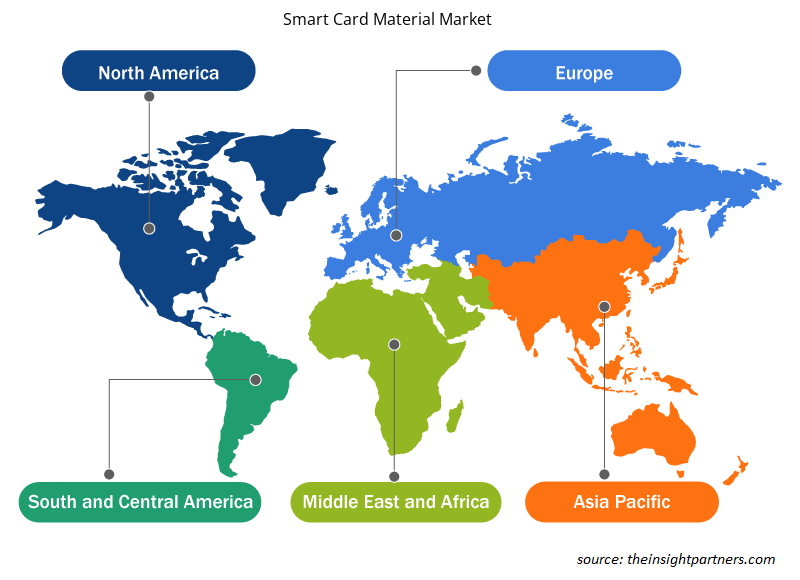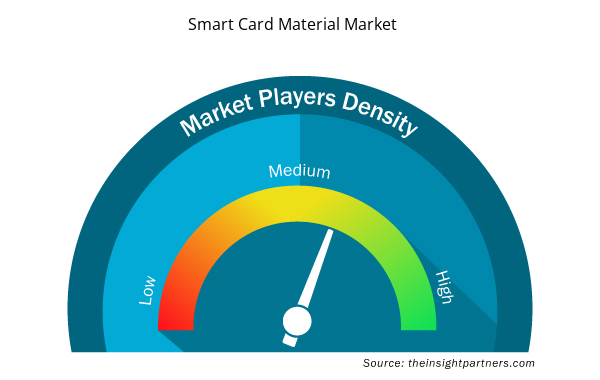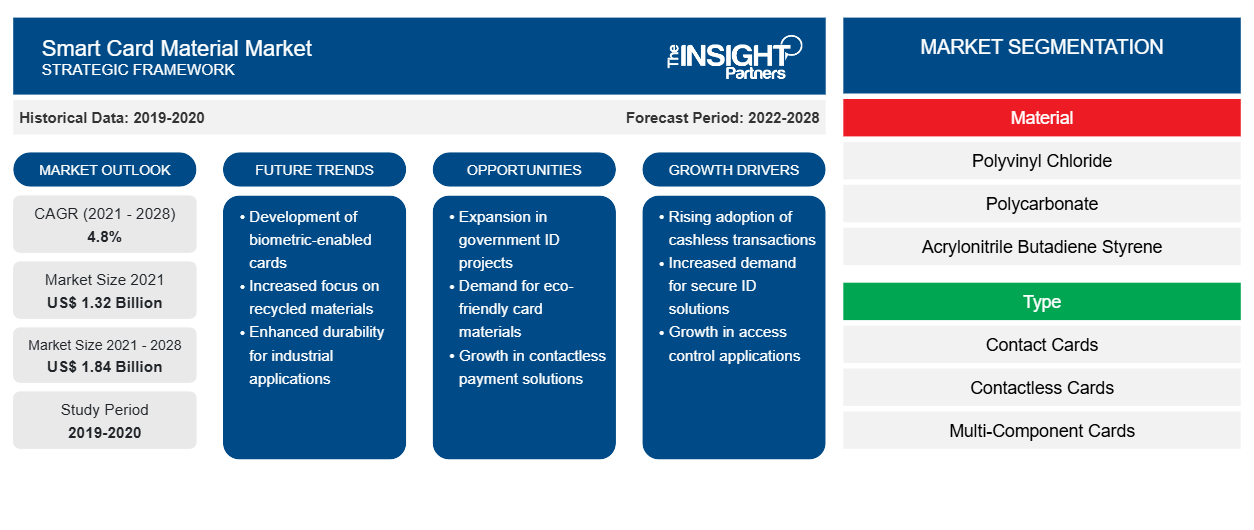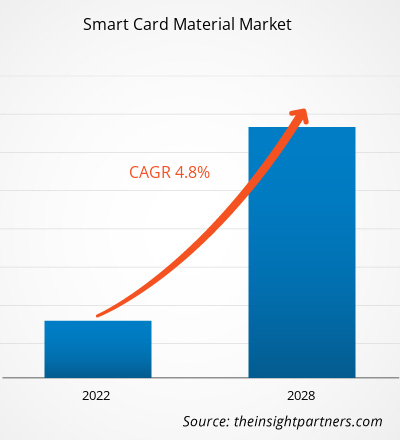スマートカード材料市場は、2021年の13億2,457万米ドルから2028年には18億3,778万米ドルに達すると予測されており、2021年から2028年にかけて4.8%のCAGRで成長すると予想されています。CAGR of 4.8% from 2021 to 2028.
スマート カードはチップ カードの一種で、データの保存と処理を行うメモリまたはマイクロプロセッサ タイプのコンピュータ チップが組み込まれたプラスチック カードです。このデータは通常、チップ内で保存および処理される値または情報、またはその両方に関連付けられています。スマート カードの素材とは、これらのカードの製造に使用される化学物質を指します。これらの素材は、情報の埋め込みと印刷をサポートします。
2020年、アジア太平洋地域は世界のスマートカード材料市場で最大のシェアを占めました。この地域のスマートカード材料の需要は、通信分野でのスマートカードの使用の増加により増加しています。さらに、グローバル化の傾向の高まり、銀行、金融サービス、保険(BFSI)業界の急増は、この地域のスマートカード材料市場の成長を促進する重要な要因です。BFSI) industry are key factors favoring the smart card material market growth in the region.
要件に合わせてレポートをカスタマイズする
このレポートの一部、国レベルの分析、Excelデータパックなど、あらゆるレポートを無料でカスタマイズできます。また、スタートアップや大学向けのお得なオファーや割引もご利用いただけます。
- このレポートの主要な市場動向を入手してください。この無料サンプルには、市場動向から見積もりや予測に至るまでのデータ分析が含まれます。
COVID-19パンデミックがスマートカード材料市場に与える影響
現在進行中のCOVID-19パンデミックは、化学および材料セクターの状況を大幅に変え、スマートカード材料市場の成長に影響を与えました。いくつかの産業セクターのパフォーマンスの大幅な低下は、スマートカード材料の需要に影響を与えています。パンデミックの影響は、さまざまなアプリケーションセグメントによって異なります。データトラフィックと音声サービスの急増は、ブロードバンドおよびモバイルデータセンターオペレーターを含む多くの通信プレーヤーに利益をもたらしました。ただし、政府によって課されたロックダウン措置により、スマートカード製造に必要なPVS、ABS、PETGなどの原材料のサプライチェーンが混乱しました。病気の蔓延は、政府およびBFSIセクターの業務に悪影響を及ぼしました。ただし、経済が事業の復活を計画しているため、今後数年間でスマートカード材料の需要は世界的に増加すると予想されます。
市場分析
通信およびヘルスケア分野で大幅な成長
スマート カードは、電気通信分野で広く使用されています。この分野でスマート カードが最もよく使用されているのは、加入者識別モジュール (SIM) カードまたはユニバーサル集積回路カード (UICC) です。これらのスマート カードは、主にポリ塩化ビニル (PVC) とアクリロニトリル ブタジエン スチレン (ABS) 材料で製造されています。この分野のアプリケーションで使用されるスマート カード技術は、過去数年間で継続的に進歩しており、これらのカードの消費量が増加しています。さらに、世界中のヘルスケア組織が、幅広い機能とアプリケーションを備えたスマート ヘルス カードを導入しています。
スマートカード材料市場の地域別洞察
予測期間を通じてスマート カード材料市場に影響を与える地域的な傾向と要因は、Insight Partners のアナリストによって徹底的に説明されています。このセクションでは、北米、ヨーロッパ、アジア太平洋、中東、アフリカ、南米、中米にわたるスマート カード材料市場のセグメントと地理についても説明します。

- スマートカード材料市場の地域別データを入手
スマートカード材料市場レポートの範囲
| レポート属性 | 詳細 |
|---|---|
| 2021年の市場規模 | 13億2千万米ドル |
| 2028年までの市場規模 | 18億4千万米ドル |
| 世界のCAGR(2021年~2028年) | 4.8% |
| 履歴データ | 2019-2020 |
| 予測期間 | 2022-2028 |
| 対象セグメント | 素材別
|
| 対象地域と国 | 北米
|
| 市場リーダーと主要企業プロフィール |
|
スマートカード材料市場のプレーヤー密度:ビジネスダイナミクスへの影響を理解する
スマート カード マテリアル市場は、消費者の嗜好の変化、技術の進歩、製品の利点に対する認識の高まりなどの要因により、エンド ユーザーの需要が高まり、急速に成長しています。需要が高まるにつれて、企業は提供品を拡大し、消費者のニーズを満たすために革新し、新たなトレンドを活用し、市場の成長をさらに促進しています。
市場プレーヤー密度とは、特定の市場または業界内で活動している企業または会社の分布を指します。これは、特定の市場スペースに、その市場規模または総市場価値に対してどれだけの競合相手 (市場プレーヤー) が存在するかを示します。
スマートカード材料市場で事業を展開している主要企業は次のとおりです。
- イーストマンケミカルカンパニー
- ペトロチャイナ株式会社
- ソルベイSA
- ケムワン
- サビック
免責事項:上記の企業は、特定の順序でランク付けされていません。

- スマートカード材料市場のトップキープレーヤーの概要を入手
アプリケーションインサイト
用途に基づいて、スマートカード材料市場は、BFSI、政府、通信、小売、ヘルスケア、ホスピタリティ、その他に分類されます。 2020年には、通信セグメントがスマートカード材料市場で最大のシェアを占めました。 スマートカードは、プリペイド(ストアードバリューメモリカード)電話カードや、携帯電話のマイクロプロセッサスマートカードベースのSIMカードまたはUICCとして使用されます。 この分野で最も売れているスマートカード製品は、量と価値の点から見て、SIMとUICCです。
世界のスマートカード材料市場で事業を展開している企業としては、Eastman Chemical Company、PetroChina Company Limited、Solvay SA、KEM ONE、SABIC、3A Composites GmbH、Teijin Limited、LG Chem、BASF SE、Westlake Chemical Corporation などがあります。
レポートの注目点
- スマートカード材料市場における進歩的な業界動向は、プレーヤーが効果的な長期戦略を策定するのに役立ちます。
- 先進国市場と発展途上国市場で事業を展開する企業が採用する事業成長戦略
- 2019年から2028年までのスマートカード材料市場の定量分析
- スマートカード材料の世界需要の推定
- 業界で活動するバイヤーとサプライヤーの有効性を示すポーターの5つの力の分析
- 競争市場の状況を理解するための最近の動向
- スマートカード材料市場の成長を牽引・抑制する要因と市場動向と展望
- 商業的利益を支える市場戦略を強調することで意思決定プロセスを支援し、スマートカード材料市場の成長につながる
- さまざまなノードにおけるスマートカード材料市場規模
- 市場の詳細な概要とセグメンテーション、およびスマートカード材料業界の動向
- 有望な成長機会のあるさまざまな地域におけるスマートカード材料市場の規模
スマートカード材料市場
素材別
- ポリ塩化ビニル(PVC)
- ポリカーボネート(PC)
- アクリロニトリルブタジエンスチレン(ABS)
- ポリエチレンテレフタレートグリコール(PETG)
- その他
タイプ別
- 連絡先カード
- 非接触型カード
- マルチコンポーネントカード
アプリケーション別
- 英国
- 政府
- 通信
- 小売り
- 健康管理
- ホスピタリティ
- その他
企業プロフィール
- イーストマンケミカルカンパニー
- ペトロチャイナ株式会社
- ソルベイSA
- ケムワン
- サビック
- 3Aコンポジット株式会社
- 帝人株式会社
- LG化学
- BASF SE
- ウェストレイクケミカルコーポレーション
- 過去2年間の分析、基準年、CAGRによる予測(7年間)
- PEST分析とSWOT分析
- 市場規模価値/数量 - 世界、地域、国
- 業界と競争環境
- Excel データセット



Report Coverage
Revenue forecast, Company Analysis, Industry landscape, Growth factors, and Trends

Segment Covered
This text is related
to segments covered.

Regional Scope
North America, Europe, Asia Pacific, Middle East & Africa, South & Central America

Country Scope
This text is related
to country scope.
よくある質問
The contactless cards segment is the fastest growing segment in the global smart card material market during the forecasted period. Contactless cards are the smart cards with contactless credentials and have a size like credit cards or debit cards. The market for the contactless cards segment is growing due to its various benefits.
The telecommunication segment held the largest share of the market in 2021. In the telecommunication industry, smart cards are used in two primary applications. Firstly, it is used as prepaid (stored value memory cards) telephone cards and as the microprocessor smart card-based subscriber identity module (SIM) or universal integrated circuit card (UICC) in mobile phones.
The contact cards segment held the largest share of the market in 2021. Contact cards are the smart cards that have a size like conventional debit and credit card. Contact smart card contains a single, embedded, and integrated circuit chip that consists of either memory or memory plus microprocessor.
The polyvinyl chloride segment held the largest share of the global smart card material market in 2021. Polyvinyl chloride is the most common and strong plastic material used for card manufacturing. The material is used for contact and contactless cards.
The major players operating in the global smart card material market are Eastman Chemical Company; PetroChina Company Limited; Solvay S.A.; KEM ONE; SABIC; 3A Composites GmbH; Teijin Limited; LG Chem; BASF SE; and Westlake Chemical Corporation; among others.
In 2021, Asia Pacific held the largest share of the global smart card material market. The major factor driving the smart card materials market in the Asia Pacific region is the increasing use of smart cards in various applications such as government, transportation, retail, and education sectors.
Trends and growth analysis reports related to Chemicals and Materials : READ MORE..
The List of Companies - Smart Card Materials Market
- Eastman Chemical Company
- PetroChina Company Limited
- Solvay S.A.
- KEM ONE
- SABIC
- 3A Composites GmbH
- Teijin Limited
- LG Chem
- BASF SE
- Westlake Chemical Corporation
The Insight Partners performs research in 4 major stages: Data Collection & Secondary Research, Primary Research, Data Analysis and Data Triangulation & Final Review.
- Data Collection and Secondary Research:
As a market research and consulting firm operating from a decade, we have published and advised several client across the globe. First step for any study will start with an assessment of currently available data and insights from existing reports. Further, historical and current market information is collected from Investor Presentations, Annual Reports, SEC Filings, etc., and other information related to company’s performance and market positioning are gathered from Paid Databases (Factiva, Hoovers, and Reuters) and various other publications available in public domain.
Several associations trade associates, technical forums, institutes, societies and organization are accessed to gain technical as well as market related insights through their publications such as research papers, blogs and press releases related to the studies are referred to get cues about the market. Further, white papers, journals, magazines, and other news articles published in last 3 years are scrutinized and analyzed to understand the current market trends.
- Primary Research:
The primarily interview analysis comprise of data obtained from industry participants interview and answers to survey questions gathered by in-house primary team.
For primary research, interviews are conducted with industry experts/CEOs/Marketing Managers/VPs/Subject Matter Experts from both demand and supply side to get a 360-degree view of the market. The primary team conducts several interviews based on the complexity of the markets to understand the various market trends and dynamics which makes research more credible and precise.
A typical research interview fulfils the following functions:
- Provides first-hand information on the market size, market trends, growth trends, competitive landscape, and outlook
- Validates and strengthens in-house secondary research findings
- Develops the analysis team’s expertise and market understanding
Primary research involves email interactions and telephone interviews for each market, category, segment, and sub-segment across geographies. The participants who typically take part in such a process include, but are not limited to:
- Industry participants: VPs, business development managers, market intelligence managers and national sales managers
- Outside experts: Valuation experts, research analysts and key opinion leaders specializing in the electronics and semiconductor industry.
Below is the breakup of our primary respondents by company, designation, and region:

Once we receive the confirmation from primary research sources or primary respondents, we finalize the base year market estimation and forecast the data as per the macroeconomic and microeconomic factors assessed during data collection.
- Data Analysis:
Once data is validated through both secondary as well as primary respondents, we finalize the market estimations by hypothesis formulation and factor analysis at regional and country level.
- Macro-Economic Factor Analysis:
We analyse macroeconomic indicators such the gross domestic product (GDP), increase in the demand for goods and services across industries, technological advancement, regional economic growth, governmental policies, the influence of COVID-19, PEST analysis, and other aspects. This analysis aids in setting benchmarks for various nations/regions and approximating market splits. Additionally, the general trend of the aforementioned components aid in determining the market's development possibilities.
- Country Level Data:
Various factors that are especially aligned to the country are taken into account to determine the market size for a certain area and country, including the presence of vendors, such as headquarters and offices, the country's GDP, demand patterns, and industry growth. To comprehend the market dynamics for the nation, a number of growth variables, inhibitors, application areas, and current market trends are researched. The aforementioned elements aid in determining the country's overall market's growth potential.
- Company Profile:
The “Table of Contents” is formulated by listing and analyzing more than 25 - 30 companies operating in the market ecosystem across geographies. However, we profile only 10 companies as a standard practice in our syndicate reports. These 10 companies comprise leading, emerging, and regional players. Nonetheless, our analysis is not restricted to the 10 listed companies, we also analyze other companies present in the market to develop a holistic view and understand the prevailing trends. The “Company Profiles” section in the report covers key facts, business description, products & services, financial information, SWOT analysis, and key developments. The financial information presented is extracted from the annual reports and official documents of the publicly listed companies. Upon collecting the information for the sections of respective companies, we verify them via various primary sources and then compile the data in respective company profiles. The company level information helps us in deriving the base number as well as in forecasting the market size.
- Developing Base Number:
Aggregation of sales statistics (2020-2022) and macro-economic factor, and other secondary and primary research insights are utilized to arrive at base number and related market shares for 2022. The data gaps are identified in this step and relevant market data is analyzed, collected from paid primary interviews or databases. On finalizing the base year market size, forecasts are developed on the basis of macro-economic, industry and market growth factors and company level analysis.
- Data Triangulation and Final Review:
The market findings and base year market size calculations are validated from supply as well as demand side. Demand side validations are based on macro-economic factor analysis and benchmarks for respective regions and countries. In case of supply side validations, revenues of major companies are estimated (in case not available) based on industry benchmark, approximate number of employees, product portfolio, and primary interviews revenues are gathered. Further revenue from target product/service segment is assessed to avoid overshooting of market statistics. In case of heavy deviations between supply and demand side values, all thes steps are repeated to achieve synchronization.
We follow an iterative model, wherein we share our research findings with Subject Matter Experts (SME’s) and Key Opinion Leaders (KOLs) until consensus view of the market is not formulated – this model negates any drastic deviation in the opinions of experts. Only validated and universally acceptable research findings are quoted in our reports.
We have important check points that we use to validate our research findings – which we call – data triangulation, where we validate the information, we generate from secondary sources with primary interviews and then we re-validate with our internal data bases and Subject matter experts. This comprehensive model enables us to deliver high quality, reliable data in shortest possible time.


 このレポートの無料サンプルを入手する
このレポートの無料サンプルを入手する